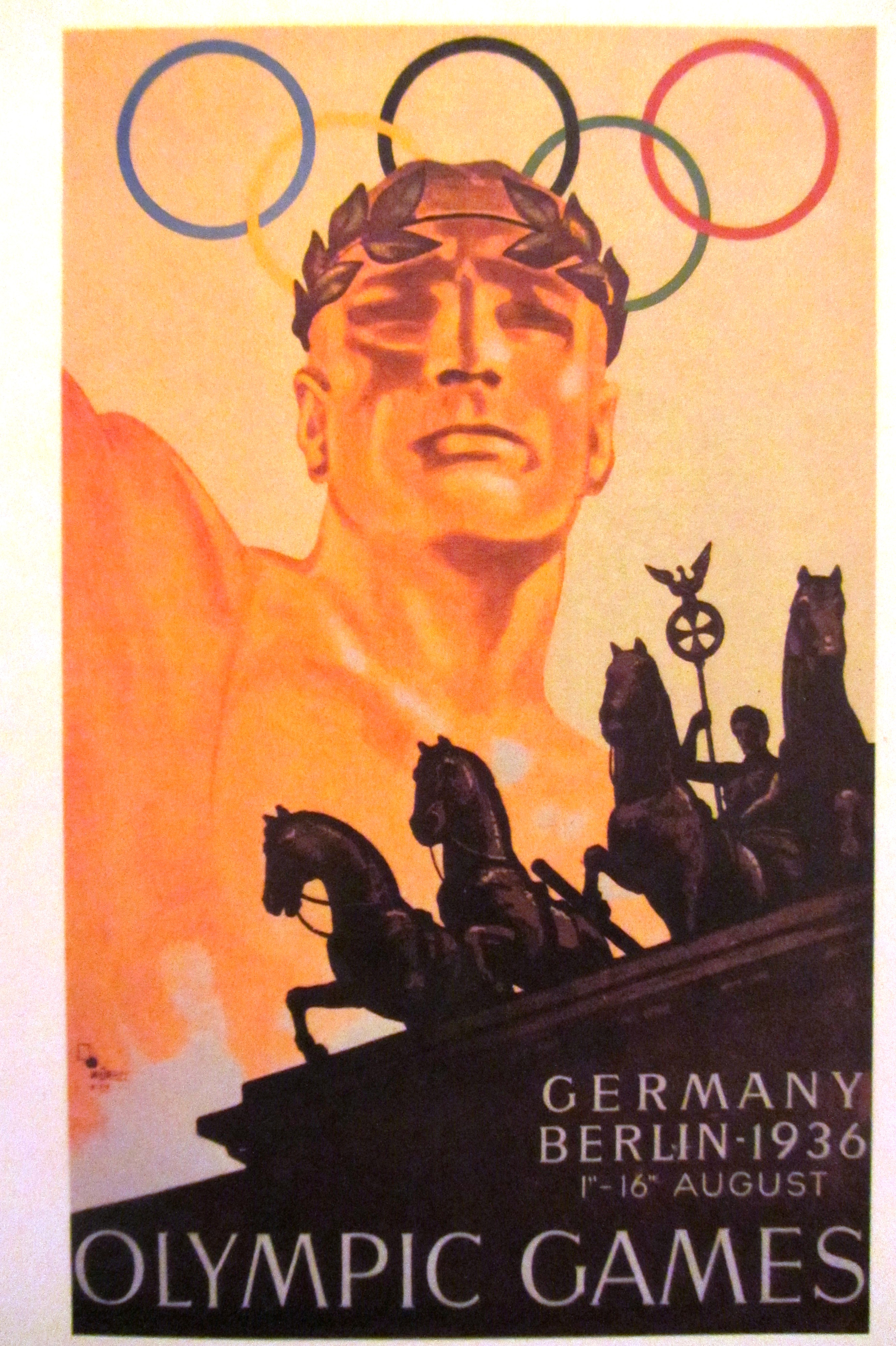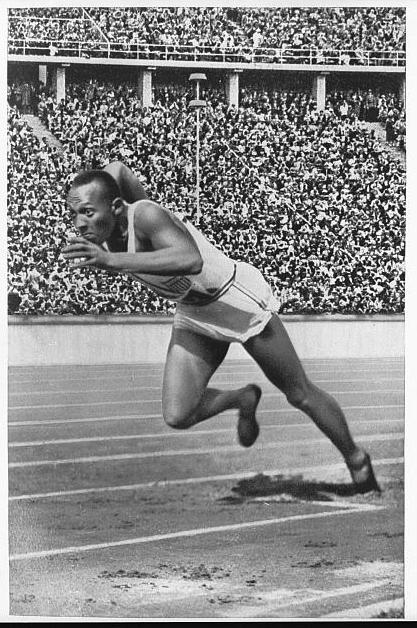This year's London 2012 Olympics were a timely reminder of Olympic Games held in the past. Germany has hosted the Olympic Games twice before – Berlin in 1936 and Munich in 1972. Both are remembered for sporting and political reasons. This spotlight will examine the controversial 1936 Berlin Olympics and its coverage within the UL collections.

A poster for the 1936 Berlin Olympics
The Berlin Olympics had been awarded to Germany before the Nazis came to power, but in August 1936 they provided a perfect opportunity for the Nazis to showcase Hitler's Third Reich to the 49 nations of the world competing for Olympic gold. One highlight of the UL's Germanic collections is "Ludwig Haymann : Die Olympischen Spiele 1936 (1936)" at F193.b.1.5, which contains contemporary photographic source material taken by Heinrich Hoffmann, the official photographer of the Nazi party. This item unusually contains viewing glasses inside the front cover with which to view the stereoscopic photographs accompanying the text. The UL also holds the catalogue of a major exhibition on the 1936 Olympics organised by Berlin's Topography of Terror Museum: "Reinhard Rürup (ed.) : 1936, die Olympischen Spiele und der Nationalsozialismus (1996)" at 416.c.99.318 as well as the score of Richard Strauss' "Olympische Hymne" at M290.a.90.624, an anthem especially composed by Strauss to celebrate the Berlin Olympics.
The 1936 Olympics will mostly be remembered for the exploitation of the Games by the Third Reich in pursuit of Nazi ideology. The Olympics were a political coup for Reich Minister of Propaganda Joseph Goebbels, who ordered the removal of anti-Semitic slogans from Jewish shops, moved "undesirables" out of Berlin, toned down the racist Nazi newspaper "Der Stürmer" and organised groundbreaking TV and radio broadcasting of the Games. The use of propaganda by Goebbels and the Nazis is explored in "Lutz Hachmeister & Michael Kloft (eds.) : Das Goebbels-Experiment, Propaganda und Politik (2005)" at C200.b.4980. A recent comprehensive biography of Goebbels "Peter Longerich : Joseph Goebbels, Biographie (2010)" is held at 571:75.c.201.13 and this makes use of a critical edition of the original Goebbels diaries "Elke Fröhlich (ed.) : Die Tagebücher von Joseph Goebbels (1993-2008)" held at 571:73.c.95.228-247.
The Berlin Games were only a partial success for the Nazis. Germany finished top of the medal table ahead of their main rivals, the United States, but the Americans dominated the Athletics events with African American Jesse Owens winning four gold medals ahead of his blond, Aryan rivals. Hitler refused to put the gold medal around Owens' neck. The exploitation of the Olympic Games by the Third Reich is examined in "Hilmar Hoffmann : Mythos Olympia (1993)" at S416.b.99.1, which is a standard critical work on the subject.

Jesse Owens
The German filmmaker Leni Riefenstahl was famously commissioned by the German Olympic Committee to make a film documenting the Berlin Games for $7 million. The film was titled "Olympia" and was released in two parts: Olympia 1. Teil – Fest der Völker and Olympia 2. Teil – Fest der Schönheit. Copies of the film are held in the Medieval and Modern Languages library at VID.G.353 and VID.G.354. Olympia was the first documentary feature film ever made of the Olympic Games and it pioneered many groundbreaking techniques such as slow motion footage, varied camera angles, tracking shots and extreme close-ups, which have since become standards of the film industry. The film remains controversial to this day due to its political context and its glorification of the Nazi era, but it is still regarded as a major landmark in the history of documentary filmmaking. The UL holds some contemporary documentation regarding the film: "Leni Riefenstahl : Schönheit im olympischen Kampf (1937)" at S416.a.93.1 and a facsimile edition of "Leni Riefenstahl : Dokumentation zum Olympiafilm (1937)" at S950.a.200.137.
After 1945, Leni Riefenstahl's close association with Hitler and the Third Reich destroyed her film career. She was arrested at the end of World War Two, but released without charge. The UL holds two editions of her personal memoirs: "Leni Riefenstahl : Memoiren (1987)" at CCC.60.241 and "Leni Riefenstahl : Memoiren, 1902-1945 (1990)" at 415.d.99.35. The library also holds a number of Riefenstahl biographies such as "Rainer Rother : Leni Riefenstahl, die Verführung des Talents (2.Aufl. 2001)" at 415:3.c.200.239 (2002 English translation at 415:3.c.200.149) and "Jürgen Trimborn : Riefenstahl, eine deutsche Karriere (2002)" at 415:3.c.200.163 (2008 English translation at 415:3.c.200.1644). For a recent critical overview of her work, consult "Markwart Herzog & Mario Leis (eds.) : Kunst und Ästhetik im Werk Leni Riefenstahls (2011)" at 415:3.c.201.442 and, for a recent assessment of her life and times comparing her with actress Marlene Dietrich, see "Karin Wieland : Dietrich & Riefenstahl, der Traum von der neuen Frau (2011)" at 571:73.c.201.5. Despite the controversy surrounding her films, when Leni Riefenstahl died in 2003, aged 101, The Economist described her as "the greatest female filmmaker of the 20th century".
L. Noble
